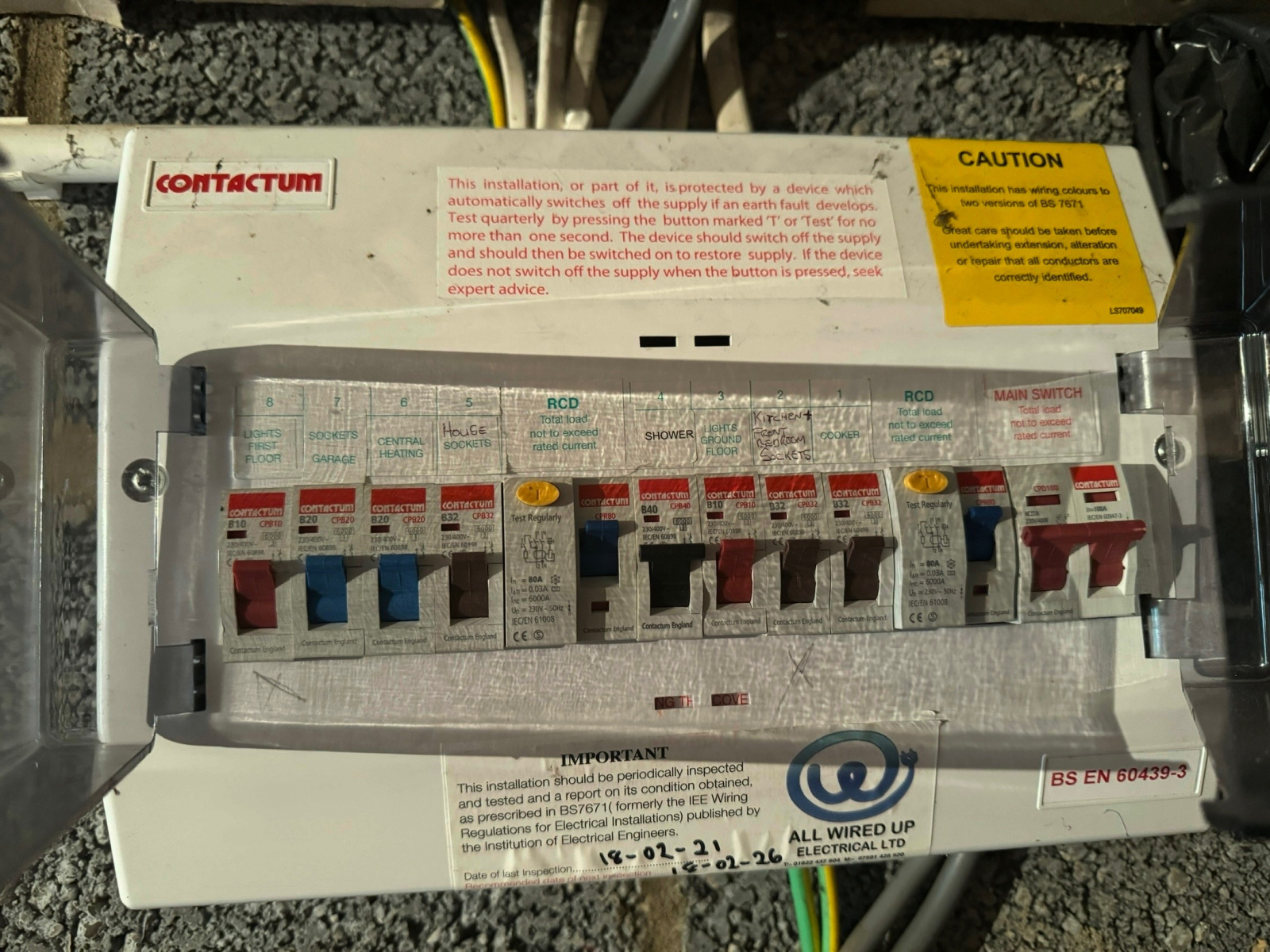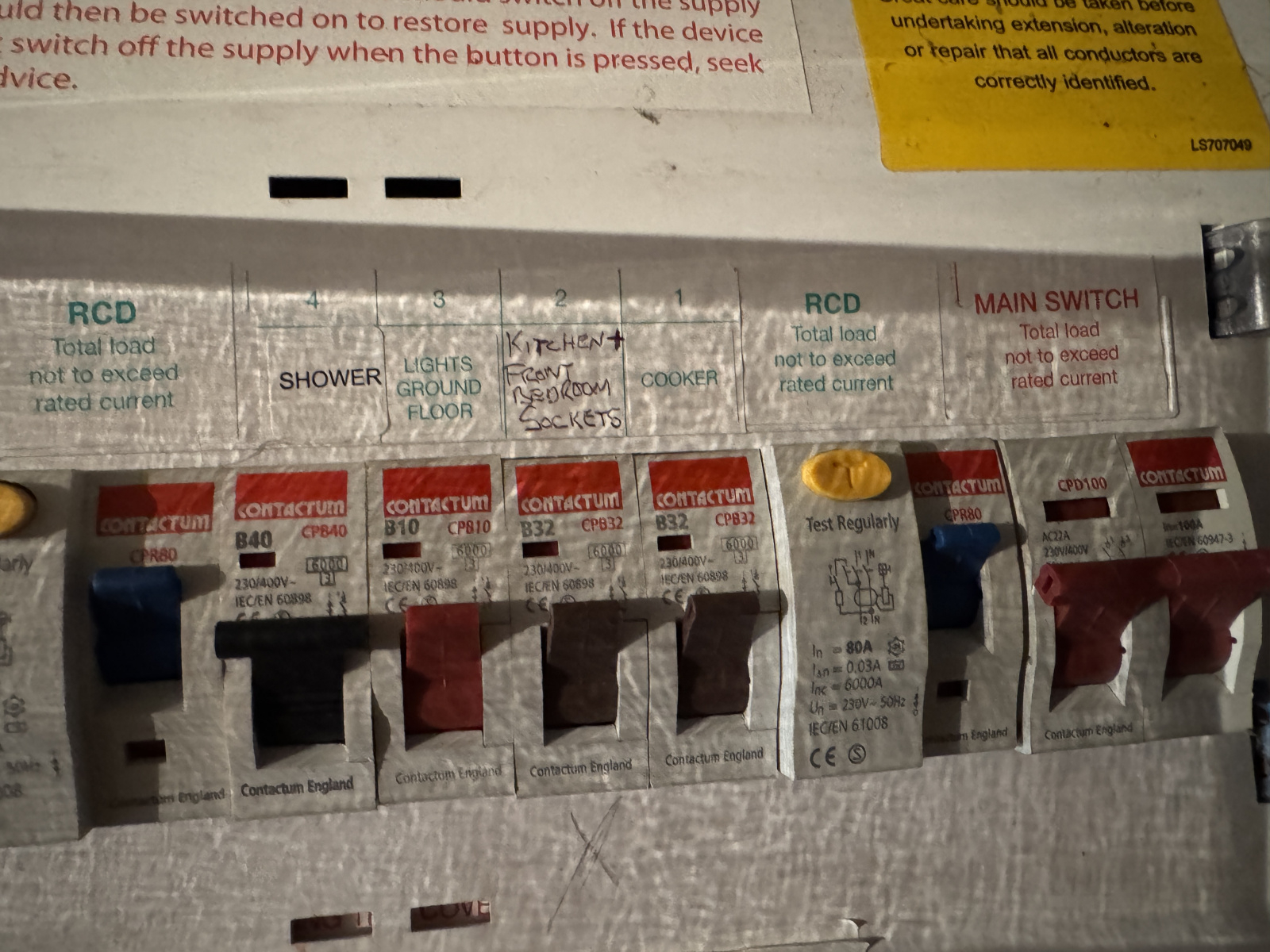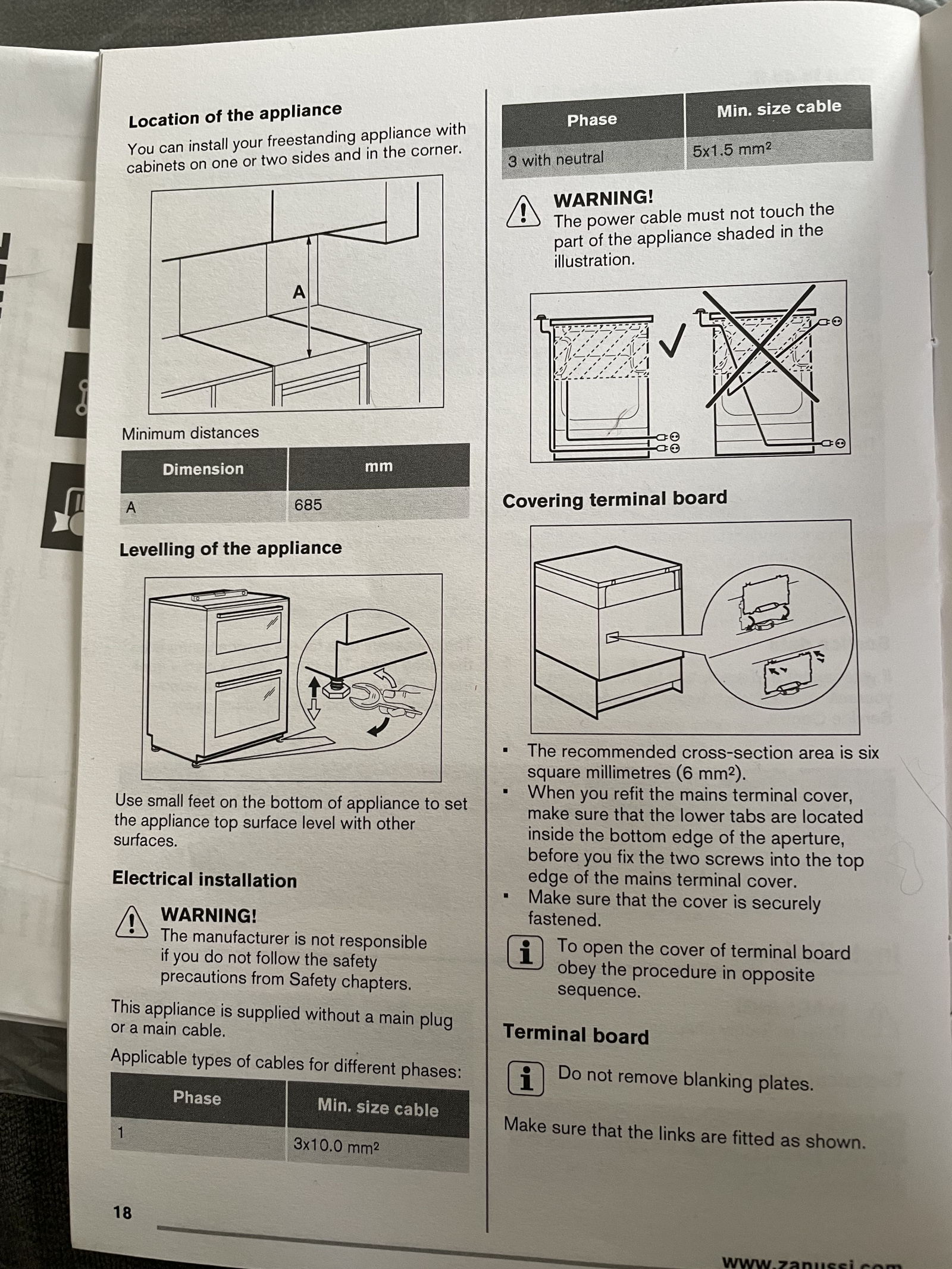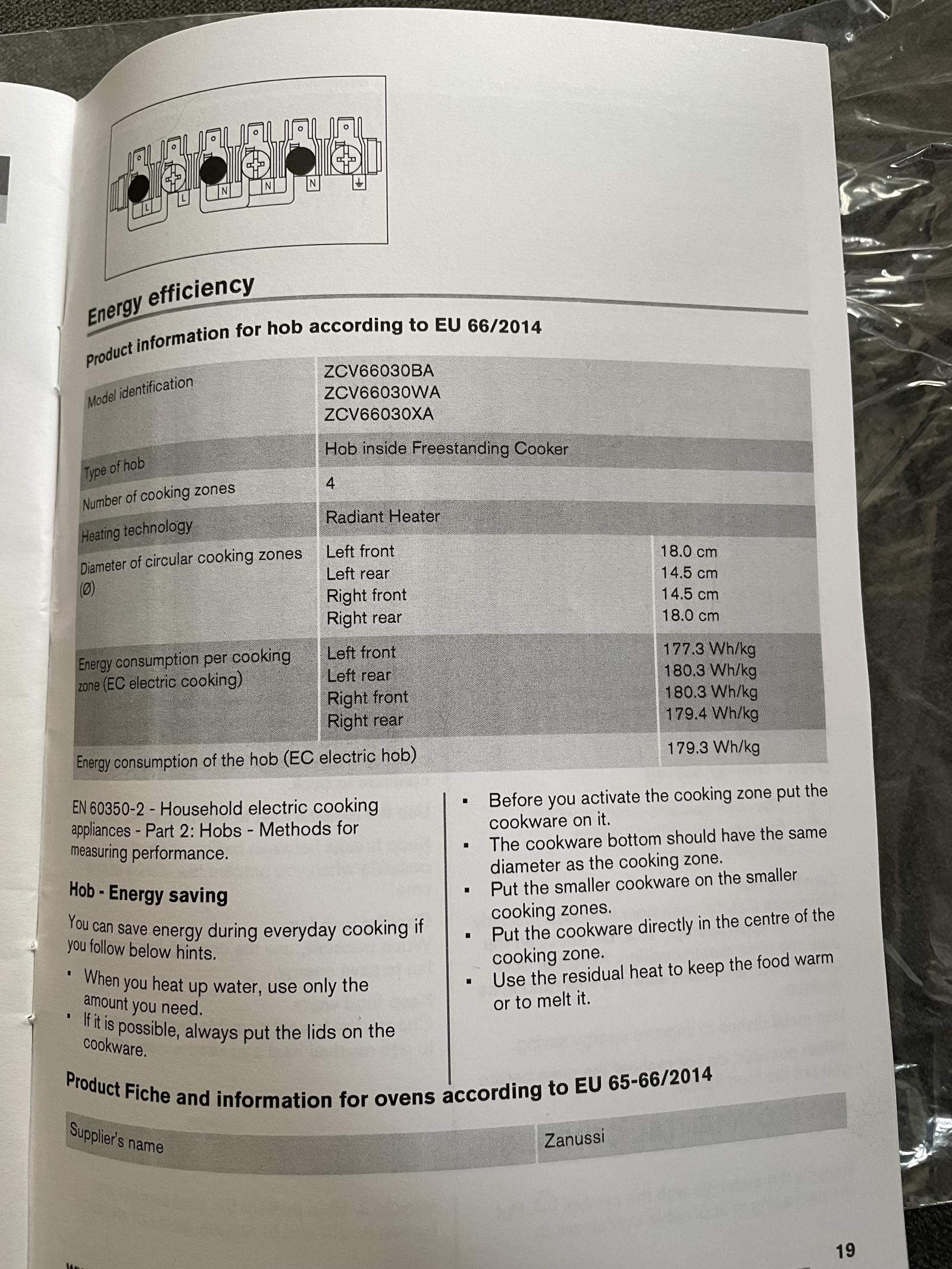We’d like to remind Forumites to please avoid political debate on the Forum.
This is to keep it a safe and useful space for MoneySaving discussions. Threads that are – or become – political in nature may be removed in line with the Forum’s rules. Thank you for your understanding.
The MSE Forum Team would like to wish you all a Merry Christmas. However, we know this time of year can be difficult for some. If you're struggling during the festive period, here's a list of organisations that might be able to help
📨 Have you signed up to the Forum's new Email Digest yet? Get a selection of trending threads sent straight to your inbox daily, weekly or monthly!
Has MSE helped you to save or reclaim money this year? Share your 2025 MoneySaving success stories!
Oven tripping the electrics
Comments
-
Catbenetar said:
So the 6mm is fine for the power coming from the oven? The electrician is incorrect?Risteard said:Catbenetar said:
Hi,Risteard said:Catbenetar said:If anyone is still following I do have an update.
We had an electrician out who said the wiring is too small to accommodate a 10kw oven. The installer really ought to have spotted this at the time it was put in.
Our options are to either try and get another oven (though most are around 10 so this will be a struggle) or have a new cable run from the oven to the fuse box.
Nightmare!
This sounds exceedingly unlikely. I presume 10kW is listed as the "total connected load". It seems inconceivable to me that an oven would be in any way capable of having a consumption of anything like 10kW (notwithstanding the likes of commercial ovens). Do you have makes and model numbers of the oven(s) and hob(s) connected to the existing cooker circuit? A typical 32A cooker circuit is typically considered to be suitable for around 15kW of cooking equipment.
The cooker is an Amica 601SS. The listing on curry’s says it has an electrical power rating of 10kw and power supply of 45amp.A direct quote from the manual for that: "Connection shuld be made with 4 mm2 twin and earth cable."Also from that manual: "The power supply cable must have these minimum requirements:
- Type: HO5VV-F (PVC insulated and sheathed flexible cable)
- 3 cores x 4 mm2 ."As I say, the usual would be a 6mm^2 supply on a 32A protective device, with 4mm^2 flexible cable for the final connection. There is no need for 10mm^2 (unless the cable has been installed through thermal insulation etc. which should instead be avoided). The equipment cannot draw 10kW (and certainly not for any prolonged period). That will be the "total connected load".Depends on the length of cable. Short runs of (say) 3m wouldn't be a problem. But if the cable between consumer unit & isolator switch is for example) 20m, then 10mm² may be required.The isolator switch should be reasonably close to the cooker, so that short run (1-2m ?) can be 6mm².Might be an idea to swap the shower MCB with the boiler so that it isn't on the same RCD. Generally not a good idea to group all the high current circuits together.Any language construct that forces such insanity in this case should be abandoned without regrets. –
Erik Aronesty, 2014
Treasure the moments that you have. Savour them for as long as you can for they will never come back again.0 -
Thanks for the reply. We have estimated that the cable length could be around 8m if we are correct on the path.FreeBear said:Catbenetar said:
So the 6mm is fine for the power coming from the oven? The electrician is incorrect?Risteard said:Catbenetar said:
Hi,Risteard said:Catbenetar said:If anyone is still following I do have an update.
We had an electrician out who said the wiring is too small to accommodate a 10kw oven. The installer really ought to have spotted this at the time it was put in.
Our options are to either try and get another oven (though most are around 10 so this will be a struggle) or have a new cable run from the oven to the fuse box.
Nightmare!
This sounds exceedingly unlikely. I presume 10kW is listed as the "total connected load". It seems inconceivable to me that an oven would be in any way capable of having a consumption of anything like 10kW (notwithstanding the likes of commercial ovens). Do you have makes and model numbers of the oven(s) and hob(s) connected to the existing cooker circuit? A typical 32A cooker circuit is typically considered to be suitable for around 15kW of cooking equipment.
The cooker is an Amica 601SS. The listing on curry’s says it has an electrical power rating of 10kw and power supply of 45amp.A direct quote from the manual for that: "Connection shuld be made with 4 mm2 twin and earth cable."Also from that manual: "The power supply cable must have these minimum requirements:
- Type: HO5VV-F (PVC insulated and sheathed flexible cable)
- 3 cores x 4 mm2 ."As I say, the usual would be a 6mm^2 supply on a 32A protective device, with 4mm^2 flexible cable for the final connection. There is no need for 10mm^2 (unless the cable has been installed through thermal insulation etc. which should instead be avoided). The equipment cannot draw 10kW (and certainly not for any prolonged period). That will be the "total connected load".Depends on the length of cable. Short runs of (say) 3m wouldn't be a problem. But if the cable between consumer unit & isolator switch is for example) 20m, then 10mm² may be required.The isolator switch should be reasonably close to the cooker, so that short run (1-2m ?) can be 6mm².Might be an idea to swap the shower MCB with the boiler so that it isn't on the same RCD. Generally not a good idea to group all the high current circuits together.0 -
The oven does have a dedicated circuit. Turn off all MCB switches on that side and turn back on one at a time to see when the RCD trips.Catbenetar said:Morning all, here are some pictures of my fuse box. The blue switch to the right of the cooker is what trips. The shower was added right before the issues began, but we were assured this was nothing to do with it.
 1
1 -
These are the installation instructions from the old cooker which we believe to be defective.What size cable would have been appropriate?

 0
0 -
Do you think the circuit could be overloaded?danrv said:
The oven does have a dedicated circuit. Turn off all MCB switches on that side and turn back on one at a time to see when the RCD trips.Catbenetar said:Morning all, here are some pictures of my fuse box. The blue switch to the right of the cooker is what trips. The shower was added right before the issues began, but we were assured this was nothing to do with it.
 0
0 -
No, that would trip one of MCB switches on an individual circuit. It's a ground fault caused by damaged insulation somewhere, either in the wiring, switch, appliance or water ingress.Catbenetar said:
Do you think the circuit could be overloaded?danrv said:
The oven does have a dedicated circuit. Turn off all MCB switches on that side and turn back on one at a time to see when the RCD trips.Catbenetar said:Morning all, here are some pictures of my fuse box. The blue switch to the right of the cooker is what trips. The shower was added right before the issues began, but we were assured this was nothing to do with it.

The cable for the oven is likely to be 6mm T&E which is fine. 10mm not needed.
If switching each circuit off and then on again on the CU points to the oven being at fault, the cable and switch to it needs to be checked.
1 -
The RCD is tripping.Catbenetar said:Morning all, here are some pictures of my fuse box. The blue switch to the right of the cooker is what trips. The shower was added right before the issues began, but we were assured this was nothing to do with it.

The cooker is on a separate circuit for power but not for earth leakage current. Getting the cooker onto its own RCD would mean that it wouldn't affect the others.1 -
We have had the cable from the switch to the cooker changed. It was borderline apparently so he switched it. No other faults detected on the rest of the line (this has been checked twice now).danrv said:
No, that would trip one of MCB switches on an individual circuit. It's a ground fault caused by damaged insulation somewhere, either in the wiring, switch, appliance or water ingress.Catbenetar said:
Do you think the circuit could be overloaded?danrv said:
The oven does have a dedicated circuit. Turn off all MCB switches on that side and turn back on one at a time to see when the RCD trips.Catbenetar said:Morning all, here are some pictures of my fuse box. The blue switch to the right of the cooker is what trips. The shower was added right before the issues began, but we were assured this was nothing to do with it.

The cable for the oven is likely to be 6mm T&E which is fine. 10mm not needed.
If switching each circuit off and then on again on the CU points to the oven being at fault, the cable and switch to it needs to be checked.In theory now things should work fine.I might now carry on a normal and await the next trip. See what happens regarding the cooker then.1 -
My guess is changing that cable to 10mm will NOT prevent the issue reoccurring as the problem to me is earth leakage not overload.If it was overload the cooker MCB would trip first well before the cable was overloaded as it is rated to trip at 32 Amps (7.4KW) which 6mm twin and earth can easily handle..Your useful photos show you have a split RCD consumer unit with the cooker, “kitchen and bedroom sockets”,“downstairs lights” AND shower ALL running through the RIGHT RCD (leak detector), ( the one with the yellow button).All the MCB’s to the left of the LEFT RCD run through that one.
You have also confirmed it is indeed the RCD that is tripping.
When (not if 😉) it trips again, please tell the electrician to read my very first reply to your original post. 😁• The rich buy assets.
• The poor only have expenses.
• The middle class buy liabilities they think are assets.1 -
Catbenetar said:
So the 6mm is fine for the power coming from the oven? The electrician is incorrect?Risteard said:Catbenetar said:
Hi,Risteard said:Catbenetar said:If anyone is still following I do have an update.
We had an electrician out who said the wiring is too small to accommodate a 10kw oven. The installer really ought to have spotted this at the time it was put in.
Our options are to either try and get another oven (though most are around 10 so this will be a struggle) or have a new cable run from the oven to the fuse box.
Nightmare!
This sounds exceedingly unlikely. I presume 10kW is listed as the "total connected load". It seems inconceivable to me that an oven would be in any way capable of having a consumption of anything like 10kW (notwithstanding the likes of commercial ovens). Do you have makes and model numbers of the oven(s) and hob(s) connected to the existing cooker circuit? A typical 32A cooker circuit is typically considered to be suitable for around 15kW of cooking equipment.
The cooker is an Amica 601SS. The listing on curry’s says it has an electrical power rating of 10kw and power supply of 45amp.A direct quote from the manual for that: "Connection shuld be made with 4 mm2 twin and earth cable."Also from that manual: "The power supply cable must have these minimum requirements:
- Type: HO5VV-F (PVC insulated and sheathed flexible cable)
- 3 cores x 4 mm2 ."As I say, the usual would be a 6mm^2 supply on a 32A protective device, with 4mm^2 flexible cable for the final connection. There is no need for 10mm^2 (unless the cable has been installed through thermal insulation etc. which should instead be avoided). The equipment cannot draw 10kW (and certainly not for any prolonged period). That will be the "total connected load".
The obvious caveat is that I'm not familiar with the particular installation in question, but it is highly probable that it is adequate.1
Confirm your email address to Create Threads and Reply

Categories
- All Categories
- 352.9K Banking & Borrowing
- 253.9K Reduce Debt & Boost Income
- 454.7K Spending & Discounts
- 246K Work, Benefits & Business
- 602.1K Mortgages, Homes & Bills
- 177.8K Life & Family
- 259.9K Travel & Transport
- 1.5M Hobbies & Leisure
- 16K Discuss & Feedback
- 37.7K Read-Only Boards







